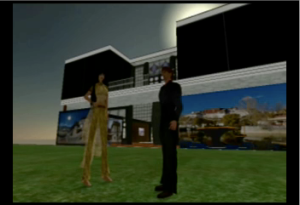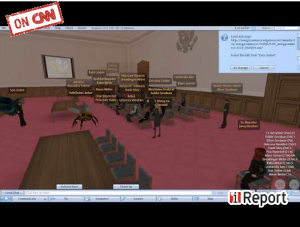As I announced earlier, I interviewed Robustus Hax, the CEO of Metaverse Broadcasting Company, Metaverse TV, “the streaming entertainment for the Virtual World and residents of Second Life.”

- Click on the image to watch MBC Live on your computer
The conversation with Hax gives us a good idea on what it means to create a TV station within Second Life, catch reporters’ attention to have them send reports as citizen journalists and to what extent journalists and media owners can control the veracity of what is being reported.
Hax created MBC “from scratch” and is now looking for SL reporters and citizen journalists who will submit content for his channel.
“The channels goal is to be the hub for all activity in the “Metaverse” and be sort of a background to people’s second lives,” Hax said.
His team of anchors and editors –Dousa Dragonash, Recka Wuyts, and Vijay Saeed- will be in charge of finding the people, the stories and coordinating all the content. Very much like in a real world television.
“I pretty much organize, edit and film most of our programming. We’re expanding pretty rapidly so we’re looking for other capable videographers,” Hax said.
MBC has a partner publication online, The Metaverse Tribune. And both publications are under special regulations in relation to Second Life. While other outlets must publish content under DMCA and copyrigh rules by Second Life, MBC is released online, not within Second Life.
As Hax explains, the channel is “outside of linden jurisdiction because its streamed from the internet.”
However, this doesn’t mean that he will release just any kind of content.
“We try to keep our content on par with PG rated sims though, each SIM has a rating Mature or PG parental guidance. On PG sims you have to watch what kind of textures and pictures are used, so we try to keep no cursing no nudity on the channel,” Hax said.
In order to do so, one of the MBC editors makes sure everyday that the content is adequate and runs fact checking on the stories that have been submitted by reporters.
Among the coverage that has been already released by MBC, there are stories about Second Life 5th Birthday, which was broadcasted live on their channel. And why broadcasting online and not in SL where most of the audience is? According to Hax, SL’s capabilities are of 100 avatars in an area, and live broadcasting online can reach more people than that.

- Click on the image to watch the video. Also available on blip.tv
Hax doesn’t provide his reporters with a code of ethics or rules that he wants to be followed when reporting SL events or news. MBC only requires reporters to make sure the facts are correct.
“There are a lot of differences obviously RL and SL but I’d say the same standard of ethics for both reporting and running a business are the same,” Hax said.
MBC launches officially on August 1st. Hax has about ten reporters to contribute to the publication, but also hopes that The Metaverse Tribune will help draw audiences to MBC.
“[The content] is usually a mix of public news stories and our own exlusives. We always invite residents to send in stories that they think need coverage,” Hax said.
In addition to that, SL popular bloggers will provide content to the Metaverse Tribune and MBC too.
The MBC is an example of how rapidly avatars can create outlets in SL and report as they would do in real life. However, while in real life both users and reporterds, as well as media company owners, are protected and forced to obey certain rules, regulations in SL are still too weak, way too unknown to compare media in both worlds.
You are welcome to leave comments on the discussion board or reacting to this post. What is your experience? Do you think media in SL should be regulated like in real life? Has your content been plagiarized?
Posted in Blogs, broadcasting, Censorship, Copy Right, Journalism, Mainstream Media, News, Second Life, SL TV
Tags: avatar, bliptv, bloggers, Blogs, Citizen Journalism, copyright, journlaism, MBC, media, metaverse, metaverse tribune, regulation, reporter, Second Life, tv










Recent Comments